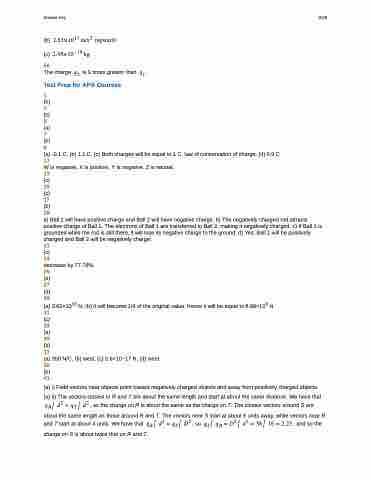Page 1641 - College Physics For AP Courses
P. 1641
Answer Key 1629
(b) ��������� ���� �������� (c) ���������� ��
56
The charge �� is 9 times greater than �� . Test Prep for AP® Courses
1
(b)
3
(c)
5
(a)
7
(b)
9
(a) -0.1 C, (b) 1.1 C, (c) Both charges will be equal to 1 C, law of conservation of charge, (d) 0.9 C
11
W is negative, X is positive, Y is negative, Z is neutral.
13
(c)
15
(c)
17
(b)
19
a) Ball 1 will have positive charge and Ball 2 will have negative charge. b) The negatively charged rod attracts positive charge of Ball 1. The electrons of Ball 1 are transferred to Ball 2, making it negatively charged. c) If Ball 2 is grounded while the rod is still there, it will lose its negative charge to the ground. d) Yes, Ball 1 will be positively charged and Ball 2 will be negatively charge.
21
(c)
23
decrease by 77.78%.
25
(a)
27
(d)
29
(a) 3.60×1010 N, (b) It will become 1/4 of the original value; hence it will be equal to 8.99×109 N
31
(c)
33
(a)
35
(b)
37
(a) 350 N/C, (b) west, (c) 5.6×10−17 N, (d) west.
39
(b)
41
(a) i) Field vectors near objects point toward negatively charged objects and away from positively charged objects. (a) ii) The vectors closest to R and T are about the same length and start at about the same distance. We have that
�� � �� � �� � �� , so the charge on R is about the same as the charge on T. The closest vectors around S are about the same length as those around R and T. The vectors near S start at about 6 units away, while vectors near R
and T start at about 4 units. We have that �� � �� � �� � �� , so �� � �� � �� � �� � �� � �� � ���� , and so the charge on S is about twice that on R and T.


